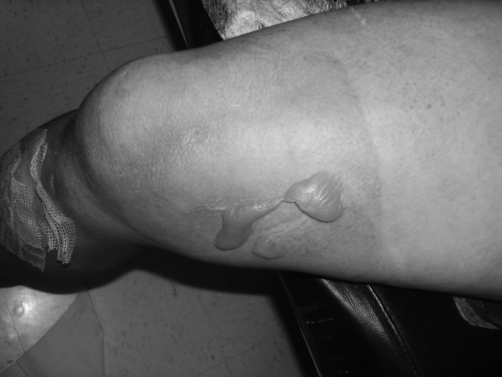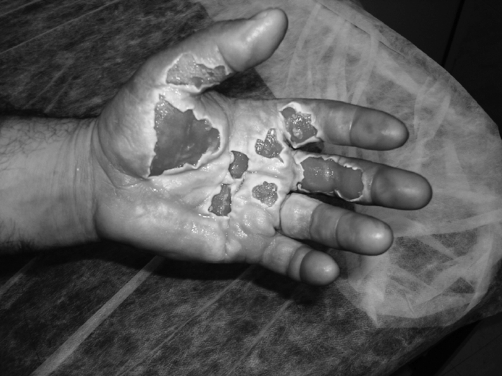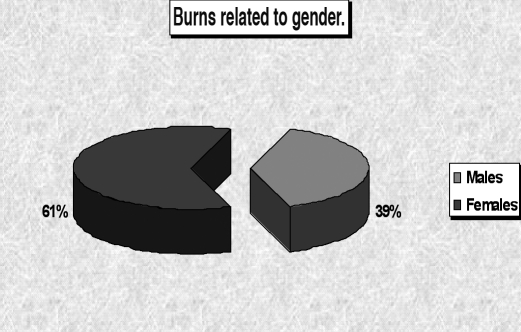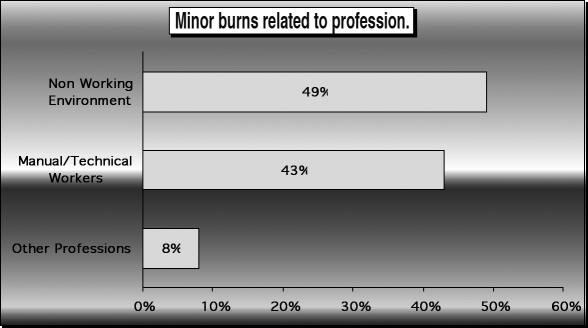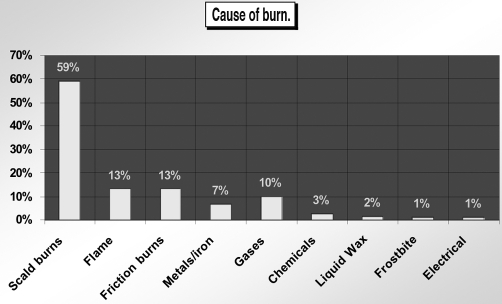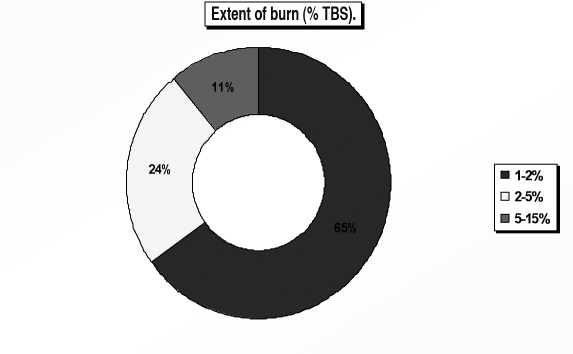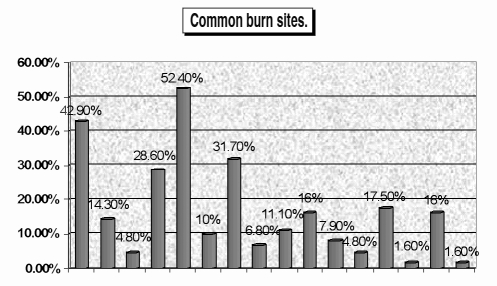Summary
We present a retrospective epidemiological study based on 1061 patients admitted to our burns centre in Greece over the 5-yr period from January 2002 to January 2007. Their average age was 25 yr, and 61% were female. The two main causes of burns were scalding and flames. Other significant causes were chemicals and friction. Electricity, frostbite, and contact burns were less frequent. The upper extremity and face were most commonly affected, followed by the lower limbs. All the patients had minor burns (less than 20% total body surface) and were treated on an out-patient basis as there was no need for hospitalization.
Keywords: EPIDEMIOLOGICAL, SURVEY, VICTIMS, HOSPITAL
Abstract
Nous présentons une étude épidémiologique rétrospective basée sur 1061 patients hospitalisés dans notre centre des brûlés pendant la quinquennale janvier 2002/janvier 2007. Leur âge moyen était de 25 ans et 61% étaient du sexe féminin. Les deux causes principales étaient l'ébouillantement et les flammes. Les autres causes significatives étaient les substances chimiques et la friction. L'électricité, la congélation et les brûlures par contact étaient moins fréquentes. Les parties du corps les plus atteintes étaient l'extrémité supérieure et le visage suivies par les membres inférieurs. Il s'agissait dans tous les cas de brûlures mineures (moins de 20% de la surface corporelle totale) et tous les patients ont été traités en régime ambulatoire parce que l'hospitalisation n'a pas été considérée nécessaire.
Introduction
Burns are an extremely stressful experience for both the burn victims and their families. An extensive burn profoundly affects a patient’s physique, psyche, financial situation, and family. Patients with extensive burns frequently die and, for those with lesser injuries, physical recovery is slow and painful. In addition to their dramatic physical effects, burn injuries frequently cause deleterious psychological complications (Fig. 1). The aetiology of burn injuries varies from country to country. Most burn patients - with minor burns and not needing hospitalization - run a great risk of developing physical and psychological sequelae. The most frequent causes of burns are flames, contact with boiling water or other hot liquids, and contact with hot objects. Less common are burns provoked by electric current, and chemical burns. Most cases of burns affecting children occur in the household environment, provoked by hot liquids spilt over the body, such as boiling water in the kitchen, hot bath water, drinks, and other hot liquids, such as cooking oil (Fig. 2). In contrast, adults burn themselves most frequently with flames, and mainly in the professional environment. In all countries, concern for burns is increasing. There are a great number of epidemiological studies about burns. Burns are among the most common injuries in children and adults. Most burns cover less than 5-10% of the total body surface area and management focuses on local care of the burn wound. The primary goals of acute burn wound management are the prevention of infection and the promotion of optimal wound closure by re-epithelialization resulting in minimal aesthetic and functional impairment.
On the basis of a report that 90% of burns could be avoided, preventive measures have been implemented in order to reduce their incidence, although this also depends on training and national legislation. Preventive training consists in instructing children from an early age how to avoid risk situations that may cause burns in the household.1-4
Fig. 1. Burn injury.
Fig. 2. Hand burn.
Materials and methods
In the emergency department at our hospital, a large number of patients who present with burns have burns of limited extent (< 10%) and do not need hospitalization. Also, many burns are neglected or even ignored by the patients themselves, eventually becoming infected and requiring hospitalization for final treatment, many days after the burn occurred. The sites involved in the burn process include the head, the upper and lower limbs, the back, and the abdomen.
This study was conducted in order to identify the demographic and sociocultural aspects of burn patients and to determine the significance of the problem of burns among all injuries in patients admitted to the Evangelismos General Hospital in Athens over a period of five years (Jan. 2002-Jan. 2007).
All burn patients admitted to the Evangelismos General Hospital Burns Unit over the five-year period (no. = 1061) were subjected to a questionnaire-interview to obtain the following data:
registration data: age, sex, occupation
clinical assessment of the wound: cause of burn, site affected, total body surface area burned
The data were obtained through a self-answered questionnaire- interview with the patients. With young children or patients who were not in a condition to respond as a result of severe injury, the data were obtained from relatives who attended the unit.
Results
Social characteristics
The ages of the burn patients ranged from 15 to over 60 years. Most of the patients (75%) were between 15 and 30 years of age. Females predominated, with an incidence of 61%, compared to a male incidence of 411 cases (39%), with a male-to-female ratio of 2 to 3. This was probably due to the larger female population (Figs. 3, 4).
Almost half the patients (no. 520/49%) were not burned in their work environment. This group is represented mainly by housewives, students and a small number of retired persons. In the working group, almost reaching the incidence of the non-working group, there were manual workers (no. = 465/43%), followed by other professions (no.76/8%) (Fig. 5).
Fig. 3. Burns and sex distribution.
Fig. 4. Burns and age distribution.
Fig. 5. Burns and professional activity.
Aetiology of the burns
Discussion with the patients revealed that the majority of burn injuries occurred at home. In more than half of the cases, domestic cooking was the activity responsible for the burns (Figs. 6, 7).
Scalding was the commonest agent of burn injuries (no. 628/59%). The commonest causative agent was boiling water (no. 460/43%), followed by cooking oil, syrup, hot chocolate, and coffee in smaller percentages. The agent and the place of occurrence of the burn injury were significantly associated; most flame, scald, and electrical burns (no. 130/13%, 628/59%, and 10-1%, respectively) were domestic, while most chemical burns (no. 25/3%) and friction burns (no. 130/12%) occurred in the street.
Fig. 6. Cause of burn.
Fig. 7. Extent of burn.
Fig. 8. Burn sites.
Clinical assessment
Most cases (65%) were second-degree burns with an extent, using the rule of nine, of 1-2% of the total body surface area. The burn agent was significantly associated with the degree, depth, and severity of the burn wound;
flame burns tended to cause mixed second- and thirddegree, deep, and severe burns. The site most commonly affected was the upper extremity (especially the forearm (52.4%), arm (31.7%), and face (no. 455-42.9%), followed by the lower extremity in half of the cases (Fig. 8).
Discussion
Epidemiological studies are effective for burn prevention programmes, both because each population seems to have its own epidemiological characteristics and because knowledge of the epidemiology of burns is needed to select target groups for preventive action.
Age and sex are important epidemiological determinants for injuries, including burns. The present study revealed that nearly half of the patients were aged 15-30 years, while those aged 60 years and over represented 2% of the cases. The high incidence among young adults may be explained by the fact that they are generally active and exposed to hazardous situations both at home and at work.
As regards sex distribution, the female population proved to be at greater risk of sustaining burns than the male population. The female predominance might be explained by the involvement of females with the handling of dangerous substances or devices both in domestic activities and at work.
Considering the agent of the burn injury, scald burns (no. 628/59%) were the commonest agent, affecting half of the cases, followed by flame (no. 130/13%) and friction burns (no. 130/13%). Flammable liquids and gasrelated materials were the commonest source of flame burns. Burn agents are highly individualized in every country, largely depending on the standard of living and lifestyle.
In the present study, a significant association was found between age and the burn injury agent. Most scald burns (no. 628/59%) were due to boiling water (no. 460/43%).Burns, especially scalds due to hot water and liquids, are in fact among the commonest of childhood accidents.
Most burns are preventable. However, prevention is difficult to achieve. The main ways are by legislation and education. Public awareness must be increased by any method possible, from posters to television. Epidemiological studies should be performed to determine the predominant causes of burns and "at risk" populations. Specific plans for prevention can be developed, based on these data.
Such at-risk risk populations are:
The very young
The very old
Lower socioeconomic groups
The mentally handicapped
The physically handicapped
The sick
Alcohol drinkers
Persons with poor access to medical treatment
When a single type of injury occurs repeatedly, the question of prevention is obvious. The problems of prevention are to determine an effective strategy, to financially support a prevention campaign, and to evaluate the effectiveness of the campaign.
Although one cannot keep children injury-free all the time, taking some simple precautions can reduce the chances that they will be burned at home.
The prevention programme must be oriented towards specific groups, such as:
The elderly, with special regard to the use of safer heating appliances
Parents with small children, to prevent in particular scalds from baths (by watching the water temperature before bathing) and in the kitchen (by watching the children during food preparation and consumption)
Teenagers, in relation to the use of fireworks as entertainment. Local authorities must introduce rules regulating the size and amount of fireworks commercially available
The industrial and working population, especially electricians and chemists
Motorists - to minimize the use of butane as car fuel.
References
- 1.Clark W.R, Fromm B.S. "Burn mortality Experience at a regional burn unit and literatu review". Acta Chir. Scand. (suppl.) 1987;537:1–126. [PubMed] [Google Scholar]
- 2.Elberg J.J., Schroder H.A., Glent-Masden L., Hall K.V. Epidemiology and the effect of a prevention programme. Burns. 1987;13:391–394. doi: 10.1016/0305-4179(87)90130-6. [DOI] [PubMed] [Google Scholar]
- 3.Lyngdorf P. Epidemiology of severe burn injuries. Burns. 1986;12:491–495. doi: 10.1016/0305-4179(86)90075-6. [DOI] [PubMed] [Google Scholar]
- 4.Silverstein P., Lack B.O. Epidemiology and prevention. In: "The Art and Science of Burn Care". In: Boswick J.A., editor. Aspen: 1987. pp. 11–19. [Google Scholar]



